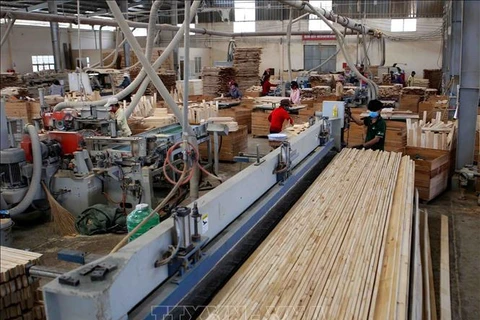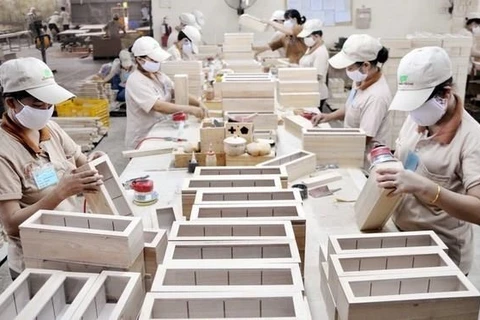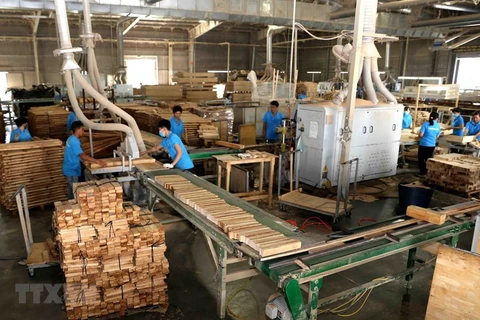HCM City (VNA) - Despite the impacts from the COVID-19 pandemic, wood and wooden product exports still posted impressive growth due to the efforts of many businesses to apply advanced technology, develop new products, and make use of online marketing channels.
Despite being repeatedly disrupted by the pandemic, the exportation of wood and wooden products still posted growth of over 16 percent in 2020 and the upwards trend continued in the first quarter of 2021.
Forestry shipments neared 4 billion USD from January to March, up 41.5 percent year-on-year. This included almost 3.7 billion USD worth of wood and wooden products and 243 million USD worth of non-wood forestry products, up 41.5 percent and 38.4 percent, respectively, according to the Ministry of Agriculture and Rural Development.
That turned the wood industry into the leading driver of agricultural and forestry exports during the period.
Nguyen Chanh Phuong, Vice Chairman of the Handicraft and Wood Industry Association of Ho Chi Minh City (HAWA), said that by tapping into its production advantages and market opportunities, Vietnam has surpassed Poland, Germany, and Italy to become the world’s second-largest wood and wooden product exporter, behind China.
He explained that the COVID-19 pandemic has hampered global trade, including the export of wood and wooden products, but at the same time created new market opportunities.
The outbreak forced people in many countries and regions, especially the US, the EU, Japan, and the Republic of Korea, which are major importers of Vietnamese wooden items, to be at home more frequently, leading to greater demand for products used in the home.
Many international purchasers, he added, have switched to Vietnamese products as the country has a safe production environment thanks to its successful pandemic control, while producers in many other countries have had to suspend production and close factories.
Vietnam’s wood and furniture businesses are also relatively accomplished at recognising and seizing market opportunities.
Tran Lam Son, director of marketing and quality management at the Thien Minh Furniture company, pointed out that the recent shift in global wood product and furniture supply chains has benefited Vietnam.
International purchasers have increasingly valued the production capacity, design, and technology of Vietnamese wood producers. Moreover, due to supply chain disruptions caused by COVID-19, global distributors now tend to diversify and seek safer supply sources, and Vietnam meets their requirements, he went on.
Pham Thi Hong Quang, General Director of the Viet Source Handicraft Co. Ltd, revealed that her company’s revenue soared 40 percent last year despite the tense developments from coronavirus outbreaks at certain points of time. The number of orders in the opening months of this year continued to rise as foreign importers began stockpiling products to prepare for the year-end shopping season.
She noted that after recognising that the pandemic could be a chance for wood and furniture products to grow, her company moved to modernise its factory and technology to improve productivity while developing new products to meet demand.
However, Duong Thi Minh Tue, member of HAWA’s executive board, suggested that as wood industry trade fairs could not take place due to the pandemic, businesses should optimise all possible trade promotion channels, from online to offline, to maintain links with partners.
Phuong also spoke of the need to capitalise on technology and digital transformation to further access buyers, adding that it is also important to promote workplace productivity and manufacture products with clear origin and that are environmentally-friendly, so as to maintain Vietnam’s new foothold in the global wooden product market./.
Despite being repeatedly disrupted by the pandemic, the exportation of wood and wooden products still posted growth of over 16 percent in 2020 and the upwards trend continued in the first quarter of 2021.
Forestry shipments neared 4 billion USD from January to March, up 41.5 percent year-on-year. This included almost 3.7 billion USD worth of wood and wooden products and 243 million USD worth of non-wood forestry products, up 41.5 percent and 38.4 percent, respectively, according to the Ministry of Agriculture and Rural Development.
That turned the wood industry into the leading driver of agricultural and forestry exports during the period.
Nguyen Chanh Phuong, Vice Chairman of the Handicraft and Wood Industry Association of Ho Chi Minh City (HAWA), said that by tapping into its production advantages and market opportunities, Vietnam has surpassed Poland, Germany, and Italy to become the world’s second-largest wood and wooden product exporter, behind China.
He explained that the COVID-19 pandemic has hampered global trade, including the export of wood and wooden products, but at the same time created new market opportunities.
The outbreak forced people in many countries and regions, especially the US, the EU, Japan, and the Republic of Korea, which are major importers of Vietnamese wooden items, to be at home more frequently, leading to greater demand for products used in the home.
Many international purchasers, he added, have switched to Vietnamese products as the country has a safe production environment thanks to its successful pandemic control, while producers in many other countries have had to suspend production and close factories.
Vietnam’s wood and furniture businesses are also relatively accomplished at recognising and seizing market opportunities.
Tran Lam Son, director of marketing and quality management at the Thien Minh Furniture company, pointed out that the recent shift in global wood product and furniture supply chains has benefited Vietnam.
International purchasers have increasingly valued the production capacity, design, and technology of Vietnamese wood producers. Moreover, due to supply chain disruptions caused by COVID-19, global distributors now tend to diversify and seek safer supply sources, and Vietnam meets their requirements, he went on.
Pham Thi Hong Quang, General Director of the Viet Source Handicraft Co. Ltd, revealed that her company’s revenue soared 40 percent last year despite the tense developments from coronavirus outbreaks at certain points of time. The number of orders in the opening months of this year continued to rise as foreign importers began stockpiling products to prepare for the year-end shopping season.
She noted that after recognising that the pandemic could be a chance for wood and furniture products to grow, her company moved to modernise its factory and technology to improve productivity while developing new products to meet demand.
However, Duong Thi Minh Tue, member of HAWA’s executive board, suggested that as wood industry trade fairs could not take place due to the pandemic, businesses should optimise all possible trade promotion channels, from online to offline, to maintain links with partners.
Phuong also spoke of the need to capitalise on technology and digital transformation to further access buyers, adding that it is also important to promote workplace productivity and manufacture products with clear origin and that are environmentally-friendly, so as to maintain Vietnam’s new foothold in the global wooden product market./.
VNA

























